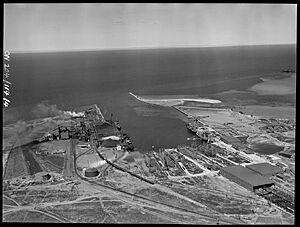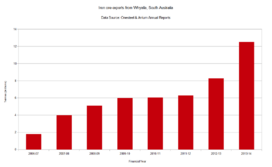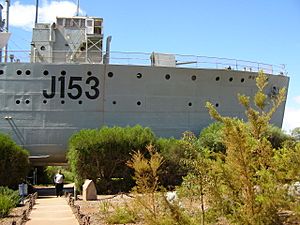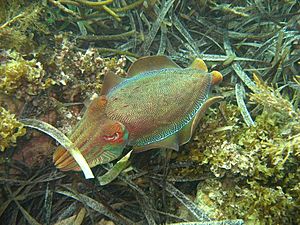Whyalla facts for kids
Quick facts for kids WhyallaSouth Australia |
|||||||||
|---|---|---|---|---|---|---|---|---|---|
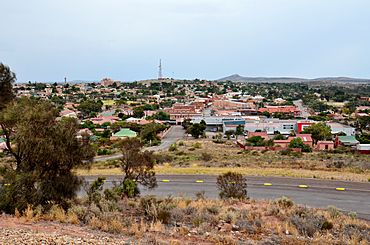
View of the city from Hummock Hill
|
|||||||||
| Established | 1920 | ||||||||
| Postcode(s) | 5600 | ||||||||
| Time zone | ACST (UTC+9:30) | ||||||||
| • Summer (DST) | ACDT (UTC+10:30) | ||||||||
| Location | 395 km (245 mi) from Adelaide | ||||||||
| LGA(s) | City of Whyalla | ||||||||
| State electorate(s) | Giles | ||||||||
| Federal Division(s) | Grey | ||||||||
|
|||||||||
Whyalla is a city in South Australia. It was first called Hummock's Hill until 1916. Whyalla is the fourth largest city in South Australia. Only Adelaide, Mount Gambier, and Gawler are bigger.
Whyalla is one of three cities that make up the "Iron Triangle." The others are Port Pirie and Port Augusta. It is a seaport on the east coast of the Eyre Peninsula. Whyalla is known as the "Steel City" because it has a large steelworks and used to build ships. The Whyalla Steelworks is the main employer in the city. It has been exporting iron ore since 1903.
Contents
About Whyalla
Whyalla is a city with different areas or suburbs. These areas stretch from east to west, starting from a natural hill called Hummock Hill. The suburbs include Whyalla, Whyalla Playford, Whyalla Norrie, Whyalla Stuart, and Whyalla Jenkins.
North of Hummock Hill, there is a port, a train yard, and a large industrial area. This industrial area includes the Whyalla Steelworks. The city is bordered by a railway line to the north, the Spencer Gulf to the east, and the Lincoln Highway to the south.
Whyalla is important for exporting iron ore. This ore is sent to countries like China.
What's in a Name?
People are not completely sure where the name Whyalla came from. In 1916, it was said to be a "native" (Aboriginal) name.
Some ideas about the name's meaning include:
- "Wajala," meaning "west" in a language from the Port Pirie area.
- "Waiala," meaning "I don't know" in a language from the Port Augusta area.
- "Dingo," "by the water," or "a place of water."
Another idea is that the name came from a place called Whyalla in England. In 1945, the company BHP said the name came from nearby Mount Whyalla. This mountain is northwest of the city, between Whyalla and Iron Knob.
Whyalla's Story
Early Days
Whyalla is on the traditional lands of the Barngarla Aboriginal people.
A sailor named William Morgan Burgoyne suggested this spot for a port. He had been hunting kangaroos in the area. At that time, there were no towns between Middleback Station and the Point Lowly Lighthouse.
A ship called the Florrie later brought a crew to set up the first settlement. It was first known as Hummocky.
The 20th Century
Whyalla was officially started as "Hummock's Hill" in 1901. This was when the BHP Whyalla Tramway was built. This railway carried iron ore from Iron Knob to the sea. The first ore shipment was in 1903. It went to Port Pirie to be used in lead smelters.
The first school opened in 1905. It was first called Hummock Hill School. Today, it is known as Whyalla Town Primary School.
Because the area was very dry, water had to be brought in by barges from Port Pirie.
The town's name officially changed to Whyalla on 1 November 1919. On 16 April 1920, the town was officially declared a city. Ore shipping to the new Newcastle Steelworks began. The town grew slowly until steelmaking and shipbuilding started in the late 1930s.
In 1937, a law helped build a blast furnace and a harbor. Construction began in 1939. A pipeline was also planned to bring water from the Murray River. A shipyard was built to make ships for the Royal Australian Navy during World War II. The city's population grew quickly, and new places like a hospital were built.
In 1941, the first ship, HMAS Whyalla, was launched. The blast furnace also started working. By 1943, over 5,000 people lived in Whyalla. The water pipeline from Morgan started working in 1943. After the war, the shipyard began making commercial ships. In 1948, people from Europe came to Whyalla, making the city more diverse.
In 1958, BHP decided to build a full steelworks in Whyalla. It was finished in 1965. The population grew very fast. The South Australian Housing Trust built 500 houses each year. Plans were even made for a city of 100,000 people. A second water pipeline was built to meet the demand.
In 1970, Whyalla became a full local government area. The shipyards closed in 1978 because of strong competition from Japanese shipbuilders. At the time, they were the biggest in Australia. The population dropped quickly from its highest point of 38,130 in 1976. The steel industry also saw a decline, affecting jobs.
The 21st Century
In 2000, BHP's steel division became a new company called OneSteel. This company made all the rail and steel sleepers in Australia. In 2012, OneSteel changed its name to Arrium. After facing financial trouble in 2016, Arrium was bought by GFG Alliance. The steelworks became part of Liberty Steel Group.
Since 2004, there has been a boom in finding minerals in northern South Australia. Whyalla was in a good spot to benefit from this. The city's economy improved, and more people moved there. The number of people without jobs also went down.
In February 2025, the Australian government announced a large support package for Whyalla and its steelworks. This was after GFG Alliance faced financial difficulties.
Historic Places
Whyalla has several places listed for their history:
- Broadbent Terrace: Whyalla High School
- 13 Forsyth Street: Hotel Bay View, Whyalla
- 5 Forsyth Street: Spencer Hotel, Whyalla
- Gay Street: World War Two Gun Emplacements, Hummock Hill
- 3 Whitehead Street: Whyalla Court House
Whyalla's Port
Since it began as Hummock Hill, Whyalla has been a port. It ships iron ore from mines in the Middleback Range.
The port got its first conveyor belt system in 1915. It could load 1,000 tonnes of ore every hour. In 1943, it took about 5 to 6 hours to load a 5,000-ton ship.
In 2007, new ways of handling ore were started. This allowed Arrium (now Liberty Steel) to load iron ore onto very large ships. These ships could be loaded in deeper water. This process involves filling barges with ore. The barges then transfer the ore to the bigger ships at sea.
In the financial year 2014–15, 12.5 million tonnes of iron ore were exported from Whyalla. In October 2015, the port loaded its largest ship ever. It carried about 205,698 tonnes of iron ore.
The port's inner harbor also receives coal shipments. This coal is used to make coke for the Whyalla steelworks. The port also exports smaller amounts of finished steel products.
Economy and Energy
Whyalla Steelworks
A big part of Whyalla's economy depends on the Whyalla Steelworks.
The steelworks changed owners from BHP to Arrium. After Arrium faced financial trouble, Liberty Steel Group bought the steelworks. Liberty Steel is part of the international company GFG Alliance.
Energy for the City
Santos has provided gas to the steelworks for many years. In February 2024, Santos and GFG Alliance agreed to discuss ways to reduce pollution from the steelworks.
The Whyalla Hydrogen Facility (WHF) was a planned project. It aimed to produce green hydrogen and generate electricity. A South Australian Government company was set up to run it. The project was cancelled in 2025.
Climate and Weather
Whyalla has a semi-arid climate. This means it has hot summers and mild winters.
- Summer (January): Average high is about 30.2°C.
- Winter (July): Average high is about 17.1°C.
- Rainfall: The city gets about 269.4 mm of rain each year. This is not much.
- Sunny Days: Whyalla has many clear, sunny days.
The hottest temperature ever recorded was 48.5°C in January 2019. The coldest was -3.2°C in June 1984 and July 1982.
| Climate data for Whyalla (33º03'00"S, 137º31'12"E, 9 m AMSL) (1945–2024 normals and extremes) | |||||||||||||
|---|---|---|---|---|---|---|---|---|---|---|---|---|---|
| Month | Jan | Feb | Mar | Apr | May | Jun | Jul | Aug | Sep | Oct | Nov | Dec | Year |
| Record high °C (°F) | 48.5 (119.3) |
48.0 (118.4) |
44.1 (111.4) |
40.4 (104.7) |
32.9 (91.2) |
26.3 (79.3) |
27.0 (80.6) |
32.1 (89.8) |
38.0 (100.4) |
42.1 (107.8) |
45.5 (113.9) |
46.8 (116.2) |
48.5 (119.3) |
| Mean daily maximum °C (°F) | 30.2 (86.4) |
29.6 (85.3) |
27.4 (81.3) |
24.0 (75.2) |
20.5 (68.9) |
17.2 (63.0) |
17.1 (62.8) |
18.5 (65.3) |
21.7 (71.1) |
24.1 (75.4) |
26.5 (79.7) |
28.3 (82.9) |
23.8 (74.8) |
| Mean daily minimum °C (°F) | 17.9 (64.2) |
17.8 (64.0) |
15.7 (60.3) |
11.9 (53.4) |
8.7 (47.7) |
6.1 (43.0) |
5.3 (41.5) |
6.0 (42.8) |
8.2 (46.8) |
10.8 (51.4) |
14.0 (57.2) |
16.0 (60.8) |
11.5 (52.8) |
| Record low °C (°F) | 5.9 (42.6) |
7.8 (46.0) |
5.5 (41.9) |
2.2 (36.0) |
−0.4 (31.3) |
−3.2 (26.2) |
−3.2 (26.2) |
−2.0 (28.4) |
0.0 (32.0) |
0.3 (32.5) |
4.4 (39.9) |
4.7 (40.5) |
−3.2 (26.2) |
| Average precipitation mm (inches) | 20.6 (0.81) |
21.9 (0.86) |
17.1 (0.67) |
21.0 (0.83) |
22.4 (0.88) |
27.3 (1.07) |
21.3 (0.84) |
21.4 (0.84) |
25.4 (1.00) |
22.9 (0.90) |
23.6 (0.93) |
24.7 (0.97) |
269.4 (10.61) |
| Average precipitation days (≥ 0.2 mm) | 3.4 | 3.0 | 3.8 | 4.9 | 8.2 | 10.7 | 10.0 | 9.7 | 7.4 | 6.6 | 5.2 | 5.0 | 77.9 |
| Average afternoon relative humidity (%) | 38 | 40 | 40 | 44 | 49 | 54 | 53 | 48 | 44 | 41 | 39 | 41 | 44 |
| Average dew point °C (°F) | 10.3 (50.5) |
11.3 (52.3) |
9.4 (48.9) |
8.4 (47.1) |
7.6 (45.7) |
6.2 (43.2) |
5.3 (41.5) |
4.7 (40.5) |
4.8 (40.6) |
5.2 (41.4) |
7.3 (45.1) |
9.5 (49.1) |
7.5 (45.5) |
| Source: Bureau of Meteorology (1945–2024 normals and extremes) | |||||||||||||
People of Whyalla
In the 2021 Australian census, Whyalla had 20,880 people.
Here are some facts about the people living in Whyalla from the 2016 census:
- About 4.7% of people were Aboriginal and Torres Strait Islander.
- Most people (73.8%) were born in Australia.
- Other countries of birth included England (7.2%), Scotland (2.4%), and the Philippines (1.4%).
- Most people (87.0%) spoke only English at home.
- Common religions were No Religion (38.7%), Catholic (19.5%), and Anglican (10.5%).
- Many people worked in Iron Smelting and Steel Manufacturing (12.4%).
- The average weekly household income was $989.
Getting Around Whyalla
Roads
The Lincoln Highway goes right through Whyalla. You can also travel by bus. A company called Stateliner runs bus services to and from Adelaide.
Trains
The BHP Whyalla Tramway was built to carry iron ore from Iron Knob. This ore was used to make steel. As the mines changed, the railway was extended to other ore sources.
In the 1960s, the railway system inside the steelworks was changed. This allowed trains from other steelworks to use it.
In 1972, a new railway line connected Whyalla to Port Augusta. A train station opened in Whyalla. Passenger trains ran from Adelaide to Whyalla until 1990. The station was taken down in 2012.
Some iron ore is still exported from Whyalla by train. In 2012, a special track was added at the port. This helps load more ore onto ships.
Air Travel
Whyalla Airport is about 4 nautical miles southwest of the city.
- Rex Airlines used to fly from Adelaide to Whyalla. They stopped flying there on July 1, 2023.
- QantasLink still flies from Adelaide to Whyalla twice a day.
Sea Travel
Whyalla has a small boat marina. You can often see dolphins there! There is also a sailing club and a boat ramp. Iron ore is exported from an offshore facility.
Media in Whyalla
Whyalla has several radio and TV stations.
- Radio stations include 5YYY FM (local community), Magic FM, and 5AU/5CS.
- Local TV stations are Seven, Nine, and Network 10.
The local newspaper is The Whyalla News. It first came out on April 5, 1940. It is now owned by Australian Community Media.
Things to See and Do
Whyalla has museums and tours where you can learn about its history.
You can see the old ship ex-HMAS Whyalla from the Lincoln Highway. You can also take a tour of it at the Whyalla Maritime Museum. This ship was built in Whyalla during World War II. It was the first ship made in the city. The museum also shows models of ships and trains. It teaches about the area's nature and Aboriginal culture.
You can take tours of the Whyalla Steelworks. These tours show how steel products are made. Tours start from the Whyalla Visitors Centre.
The Mount Laura Homestead National Trust Museum tells the story of the town's growth. It is run by volunteers.
Whyalla also has a famous beach. There are shops and pop-up stalls near the beach car park.
Nature and Wildlife
Every year, from May to August, many Australian giant cuttlefish come to the shallow waters north of Whyalla. Divers and snorkelers can see them in water that is one to six meters deep. Popular spots to see them are Black Point, Stony Point, and Point Lowly.
Dolphins often visit the Whyalla marina. However, people worry that they might become too used to humans.
The Whyalla Conservation Park lets you see the natural dry environment. You can walk on trails and climb Wild Dog Hill. From the top, you can see the landscape and learn about native plants.
Fishing Fun
You can launch boats at the Whyalla and Point Lowly North marinas. The Whyalla Marina also has a jetty with lights at night for fishing.
Whyalla used to have a big annual Snapper Fishing Competition. It attracted people from all over Australia. But because of too much fishing, there is now a ban on catching Snapper until June 30, 2026. So, the competition has stopped for now.
Politics in Whyalla
State and Federal Government
Whyalla is part of the state electoral district of Giles. This area is currently represented by Labor MP Eddie Hughes.
For federal politics, Whyalla is in the division of Grey. This area has been represented by Liberal MP Rowan Ramsey since 2007.
Local Government
Whyalla is part of the City of Whyalla local government area. This area also includes Point Lowly and some less populated areas nearby.
Learning in Whyalla
Primary Schools
Whyalla has several primary schools, including:
- Whyalla Town Primary School
- Fisk Street Primary School
- Long Street Primary School
- Hincks Avenue Primary School
- Memorial Oval Primary School
- Whyalla Stuart Campus
- Nicolson Avenue Primary School
- Sunrise Christian School
- St Teresa's and Our Lady Help of Christians (both part of Samaritan College)
Secondary Schools
Before 2022, secondary education was provided by Whyalla High School, Stuart High School, Samaritan College, Edward John Eyre High School, and Saint John's College, Whyalla. Saint John's College is one of the three schools that form Samaritan College.
On November 1, 2017, a new high school was announced for Whyalla. It would combine Edward John Eyre, Stuart High, and Whyalla High Schools. This new school was built near the University of South Australia and TAFE SA campuses.
In 2022, Whyalla Secondary College opened. It can hold 1500 students. The company that built it won an award for their work.
Higher Education
For education after high school, Whyalla has:
- The Spencer Institute of TAFE.
- The Whyalla Campus of the University of South Australia. This campus offers programs in business, social work, nursing, and research in rural health.
Arts and Culture
The D'Faces of Youth Arts group has offered workshops for young people since 1994. They teach theatre, dance, visual arts, and music.
The Whyalla Recording Scholarship is given each year to young residents aged 12 to 21.
- The first winner in 2017 was Breeze Millard.
- In 2018, Liberty Tuohy and Shakira Fauser won. Jaylee Daniels was a runner-up.
- In February 2019, Jaylee Daniels' song "Papa's Song" reached number 7 on the iTunes Australia Country Chart. Shakira Lea's "I Miss You" reached number 18.
- In 2021, Jaylee (with "Tonight") and Shakira (with "Drowning") released their second songs. Jaylee Daniels' "Tonight" reached number 3 on the iTunes Australia Singer Songwriter Chart in February 2021.
Sports in Whyalla
The Whyalla Football League is an Australian rules football competition. It has about six clubs. In 1998, Bennett Oval hosted a National Rugby League match.
Whyalla also has sports like Basketball, Hockey, Soccer, and Boxing. The Whyalla Basketball Association and the Whyalla Soccer Association are very popular.
Hockey is also popular, with the Whyalla Hockey Association attracting many players and schools. Fishing is also a favorite activity in Whyalla. Its beaches and jetty make it a great place to fish in the Eyre Peninsula.
Whyalla Speedway (also called Westline Speedway) is located northwest of the city. It opened in 1972 and hosts races for many types of cars. It also hosts motorcycle speedway events.
Sister Cities
Whyalla has a sister city: Texas City, Texas in the United States. This connection was made in 1984.
Whyalla also has ties with Ezhou in China. This sister city relationship was re-established in 1997.
Famous People from Whyalla
Many notable people come from Whyalla, including:
- Robert Bajic – soccer player
- Shantae Barnes-Cowan – actress
- Lachlan Barr – soccer player
- Edwina Bartholomew – journalist and TV presenter
- Max Brown – politician
- Brett Burton – former AFL player
- Alan Didak – AFL player
- Karyne Di Marco – hammer thrower
- Alistair Edwards – Australian soccer player
- Connie Frazer – poet and writer
- Sophie Gonzales – author
- Gary Gray – politician
- Levi Greenwood – AFL player
- Leigh Hoffman – cyclist
- Graeme Jose – Olympic cyclist
- Rex Patrick – senator
- Ben Pengelley – cricketer
- Ian Rawlings – TV actor
- Barrie Robran – football player
- Vern Schuppan – former Formula One driver
- Robert Shirley – AFL player
- Peter Stanley – historian
- Carl Veart – international soccer player
- Darryl Wakelin – AFL footballer
- Shane Wakelin – AFL footballer
- Isaac Weetra – AFL player
- Sean Williams – science fiction author
- Douglas Wood – engineer
- Bianca Woolford – para-cyclist
- Stephen Yarwood – former Lord Mayor of Adelaide
Images for kids
-
QF 3.7-inch AA gun from World War II at Hummock Hill



